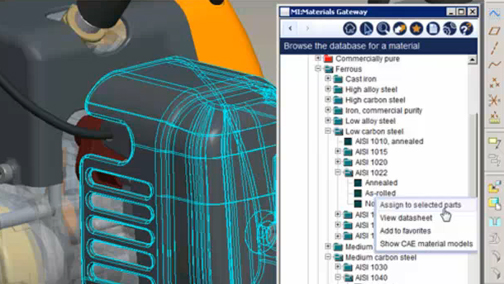Latest News
October 19, 2010

At the moment, Dassault Systemes’ SolidWorks remains one of the few leading CAD software with a fully integrated sustainability module (Sustainability Xpress), but perhaps not for much longer. SolidWorks’ rival Autodesk has just struck up a partnership with Granta Design, which describes its specialty as “material intelligence.”
Granta currently offers a product called Granta MI (now in release 4.0), developed to “control, access, analyze, and apply data related to materials.” Those who want to integrate its reporting and analysis functions with their CAD programs may use Granta MI Gateway.
According to the announcement from Autodesk, “Granta and Autodesk are co-developing software that will add new sustainable design capabilities to the Autodesk solution. The companies are working closely to integrate Granta’s eco design methods into Autodesk software, helping designers to estimate the environmental impact of a product and make more sustainable design decisions. The new tools will access and use data from Granta’s world-class materials information database.”
Sarah Krasley, Autodesk’s industry manager for sustainability, said, “The capability the companies are co-developing will be made available to Autodesk manufacturing customers as part of the Autodesk solution for digital prototyping. We expect it will appeal especially to consumer product designers and engineers as well as building products manufacturers and student users.”
Autodesk also has a partnership with Sustainable Minds, which resulted in a function that allows Autodesk Inventor users to directly import an Inventor model’s bill of materials (BOM) into Sustainable Minds’ browser-based environmental impact analysis software. According to Krasley, “Sustainable Minds’ lifecycle assessment methodology helps give industrial designers the knowledge and tools required to understand the environmental impacts of a new product, particularly in the conceptual design phase. We are partnering with Granta because the organization offers the most extensive materials information database and technology, unique capabilities that will benefit Autodesk manufacturing customers and positively contribute to the Autodesk digital prototyping solution.”
Krasley added, “It is too early to say when customers will have access to the new, web-based software, but we are working aggressively as we know that materials analysis and selection is increasingly important for companies in assessing the environmental impact of their material choices, to respond to customer demand and comply with regulation.”
Autodesk also has a web-based applet called Project Krypton, currently hosted at Autodesk Labs. The program is designed to give a “plastic part’s manufacturability, cost efficiency, and the environmental impact of the selected material.” It works as an add on to not only Autodesk’s own product but also two rival packages: Pro/ENGINEER and SolidWorks.
Most lifecycle assessment (LCA) or environmental impact calculation programs use carbon output as the base unit to rate a product. With Autodesk’s upcoming product, Krasley said, “There will be several units upon which the environmental footprint will be calculated. The units will align with the issues our customers face in adhering to a myriad of reduction targets associated with sustainable design.
Subscribe to our FREE magazine, FREE email newsletters or both!
Latest News
About the Author
Kenneth Wong is Digital Engineering’s resident blogger and senior editor. Email him at [email protected] or share your thoughts on this article at digitaleng.news/facebook.
Follow DE





